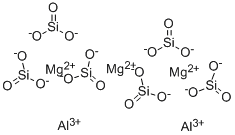ATTAPULGITE
- CAS NO.:12174-11-7
- Empirical Formula: 2Al.3Mg.6O3Si
- Molecular Weight: 583.377
- MDL number: MFCD01774804
- EINECS: 229-146-5
- SAFETY DATA SHEET (SDS)
- Update Date: 2025-12-17 09:50:04

What is ATTAPULGITE?
Chemical properties
solid
Chemical properties
Attapulgite occurs as a light cream colored, very fine powder. Particle size ranges depend on the grade and manufacturer.
The Uses of ATTAPULGITE
Worldwide attapulgite production in 1983 was estimated at about 1.1 million tons, of which 84% came from the United States. The primary use of attapulgite is as an animal waste absorbent (cat litter). Other important uses of attapulgite in the United States are as a component of drilling muds, as oil and grease absorbents, and in fertilizer and pesticide formulations.
The Uses of ATTAPULGITE
Excipient.
Indications
When used in medicine, it physically binds to acids and toxic substances in the stomach and digestive tract. For that reason, it has often been used in antidiarrheal medications. Attapulgite is an adsorbent.
Background
Attapulgite is a magnesium aluminium phyllosilicate which occurs in a type of clay soil common to the Southeastern United States. When used in medicine, it physically binds to acids and toxic substances in the stomach and digestive tract. For that reason, it has often been used in antidiarrheal medications. Until 2003, it was the active ingredient used in Kaopectate, before that product was reformulated with bismuth subsalicylate.
Definition
A hydrated aluminum-magnesium silicate, the chief ingredient of fuller’s earth.
Production Methods
Attapulgite occurs naturally as the mineral palygorskite.
Hazard
Possible carcinogen.
Pharmaceutical Applications
Attapulgite is widely used as an adsorbent in solid dosage forms. Colloidal clays (such as attapulgite) absorb considerable amounts of water to form gels and in concentrations of 2–5% w/v usually form oil-in-water emulsions. Activated attapulgite, which is attapulgite that has been carefully heated to increase its absorptive capacity, is used therapeutically as an adjunct in the management of diarrhea.
Pharmacokinetics
Attapulgite is an adsorptive magnesium aluminium phyllosilicate which binds to toxins, bacteria and water.
Safety Profile
Suspected carcinogen with experimental neoplastigenic and tumorigenic data. When heated to decomposition it emits acrid smoke and irritating fumes.
Safety
Attapulgite is widely used in pharmaceutical formulations and is generally regarded as an essentially nontoxic and nonirritant material. It is not absorbed following oral administration. In oral preparations, activated attapulgite up to 9 g is used in daily divided doses as an adjunct in the management of diarrhea.
Metabolism
Not Available
Storage
Attapulgite can adsorb water. It should be stored in an airtight container in a cool, dry, location.
Incompatibilities
Attapulgite may decrease the bioavailability of some drugs such as loperamide and riboflavin. Oxidation of hydrocortisone is increased in the presence of attapulgite.
Regulatory Status
Included in nonparenteral medicines licensed in a number of countries worldwide including the UK and USA.
Properties of ATTAPULGITE
| Density | 2.2 g/cm3 |
| color | White or gray monoclinic or orthorhombic crystals |
| Dielectric constant | 1.8(Ambient) |
| Stability: | Stable. |
| IARC | 2B (Vol. 68) 1997, 3 (Vol. 68) 1997 |
| EPA Substance Registry System | Attapulgite (12174-11-7) |
Safety information for ATTAPULGITE
Computed Descriptors for ATTAPULGITE
ATTAPULGITE manufacturer
New Products
Indole Methyl Resin tert-butyl 9-methoxy-3-azaspiro[5.5]undecane-3-carboxylate Boc-His(Boc)-OH 2-CTC Resin 4-Chloro-7-tosy1-7Hpyrrolo[2,3-d]pyrimidine 5,7-Dibromo-1H-indole 2,5-dichloro-N-hydroxy-4,6-dimethylpyridine-3-carboximidamide 2,2-Dimethoxy-7-azaspiro[3.5]nonane hydrochloride 4-chloromethyl-5-methyl-1,3-dioxol-2-one (DMDO-Cl) R-2-BENZYLOXY PROPIONIC ACID 1,1’-CARBONYLDIIMIDAZOLE 1,1’-CARBONYLDI (1,2-4 TRIAZOLE) N-METHYL INDAZOLE-3-CARBOXYLIC ACID 4-((2-hydroxyethyl)thio)benzoic acid 1-(TERT-BUTOXYCARBONYL)-2-PYRROLIDINONE Methyl 6-methylnicotinate 3-Pyridineacrylic acid tert-Butyl carbazate TETRAHYDRO-2H-PYRAN-3-OL 2-((4-morpholinophenylamino) (methylthio) methylene) malononitrile 3-(4-morpholinophenylamino)-5-amino-1H-pyrazole-4-carbonitrile 2,4-dihydroxybenzaldehyde 1,3-Diethyl-1,3-Diphenylurea Methyl 2-methylquinoline-6-carboxylateRelated products of tetrahydrofuran








You may like
-
 12174-11-7 Attapulgite 99%View Details
12174-11-7 Attapulgite 99%View Details
12174-11-7 -
 12174-11-7 99%View Details
12174-11-7 99%View Details
12174-11-7 -
 Attapulgite 98%View Details
Attapulgite 98%View Details
12174-11-7 -
 Attapulgite 12174-11-7 98%View Details
Attapulgite 12174-11-7 98%View Details
12174-11-7 -
 12174-11-7 Attapulgite 98%View Details
12174-11-7 Attapulgite 98%View Details
12174-11-7 -
 12174-11-7 98%View Details
12174-11-7 98%View Details
12174-11-7 -
 12174-11-7 99%View Details
12174-11-7 99%View Details
12174-11-7 -
 Thiourea 99% ARView Details
Thiourea 99% ARView Details
62-56-6
